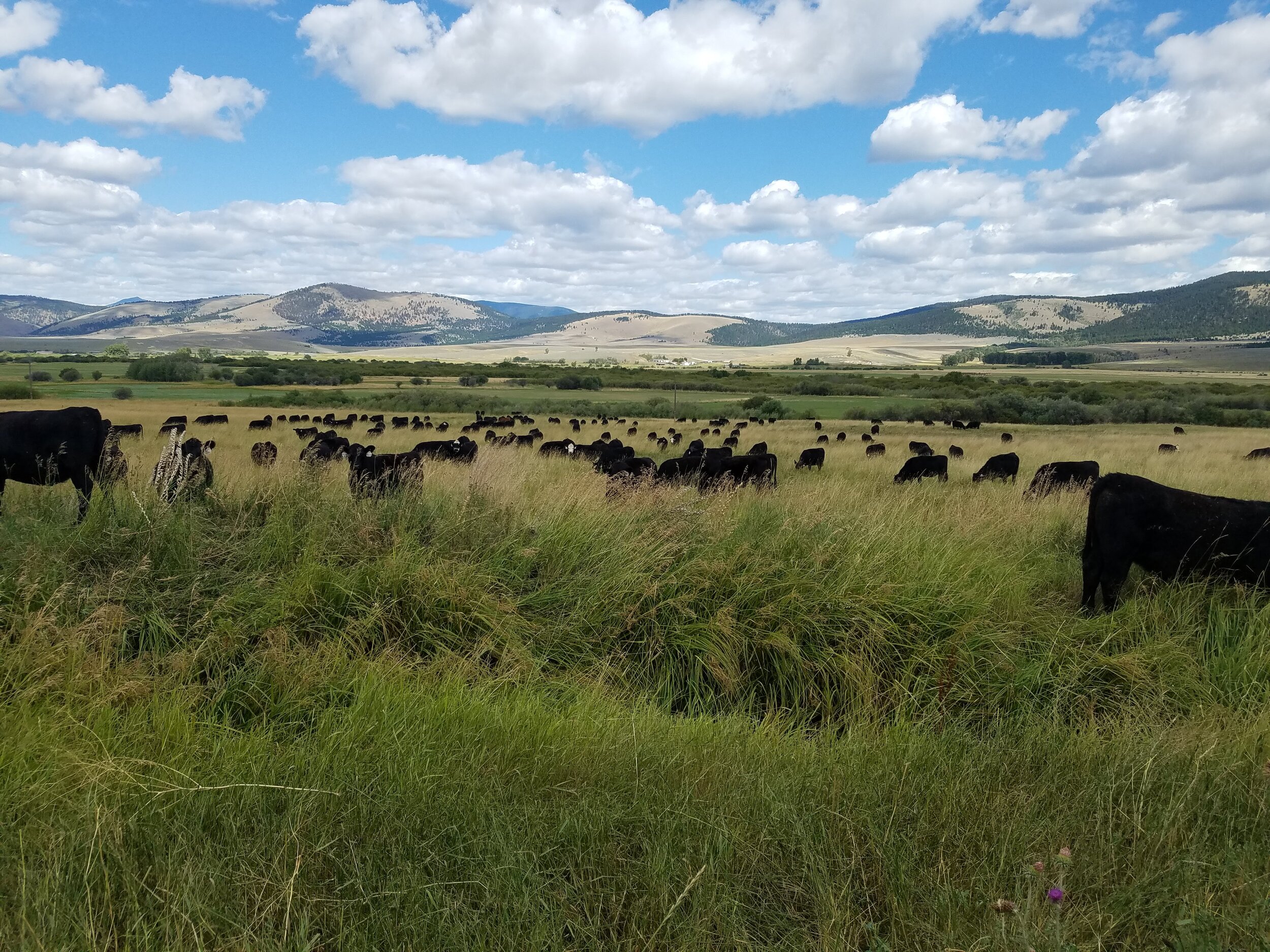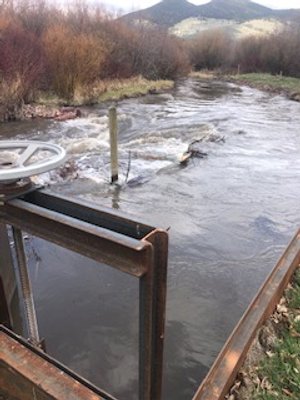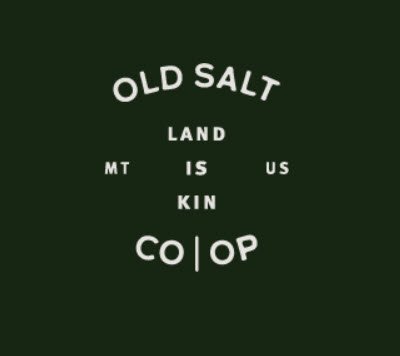Looking ahead to 2022
One thing that is always true of land management is that there will always be a lot to learn, and a lot to improve on. We thought we’d take a minute to share some, “new years resolutions.” Some projects we’d like to tackle, and management we’d like to improve on in 2022. This of course would have been more timely in January, but hey, being a little behind is about how things go on the ranch.
Lower irrigated pasture
Intermediate Rangelands
Improving grazing management on some our our intermediate rangelands.
While we’ve moved to pretty intensive grazing, (moving cattle every 1-3 days), on most of our irrigated pastures, accomplishing that on rangeland and mountain pastures is more challenging. The pastures are bigger, and less productive, requiring more temporary fencing and more labor to achieve the same result with less cows. Water can be a big challenge. Managing more intensively requires larger numbers of cattle, and large numbers of cattle need larger water sources, which can be challenging on our intermediate pastures where water tanks are filled by small springs instead of pumped from wells.
We think that these intermediate pastures are one place we could potentially improve our grazing management. For example, on one area of the ranch, shown in the picture above-right, development of water resources and maybe some fencing could allow us to potentially bring more cattle for less time, and shorten grazing periods. In addition, it may allow us to have more flexibility in the season of grazing. Currently these pastures are grazed in the spring every other year, but we’d like to try grazing them 2 out of every 3 years, grazing once in the spring, once in the fall, and resting them in the third year. Although they would be used a little more often, they would actually get 2 full years of rest during the growing season, hopefully allowing the pasture to produce more total biomass and organic matter to be trampled into the soil during grazing events.
We are currently working with the NRCS and other ranches in the valley to develop a TIP, or a targeted implementation plan for the area. If we are able to qualify, it will help provide funds for a coordinated effort across the valley on multiple ranches to develop better stock water, fencing, or other resources and improve cattle distribution and managed grazing.
An irrigation diversion on the Mannix Ranch.
Ryen Neudecker with Trout Unlimited walks Nevada creek with Bryan Mannix to assess potential stream restoration work.
Restoration Work on Nevada Creek
Nevada Creek flows through the heart of the Mannix ranch, and is the source for much of our irrigation water, either through filling the Nevada Creek Reservoir above the ranch, or through diversions directly out of the creek.
The stream has been impacted throughout the years by multiple factors, including the addition of the reservoir and the changes in stream flows that brings, by irrigation, by some brush clearing and farming work, and in some areas by cattle that have perhaps had too much access for too long in some areas, degrading banks and increasing sedimentation. That includes some impacts in other areas, but also includes our own land, and land that we more recently came to manage.
However for the last 10 years or so Trout unlimited has been working with local land owners to restore the creek, starting upstream of us. Its been great to all ready start seeing increases in stream health and fish populations in that short time from work that was done on our upstream neighbors places.
We're excited that this next year we may get a chance to do some work with them on portions of the creek that flow through our ranch. While this is preliminary, work may include lengthening the creek in a few areas by restoring it into an old stream channel that was cut off, removing sediment, improving some of our irrigation diversions, planting of some tree and willows in some areas, and reconstructing the flood plain in a few areas.
Although we have all ready taken management steps to protect riparian areas, including establishing off-stream water and riparian pastures that limit stock access to short grazing events, we may add some additional management changes after the work is done. For example some smaller areas may need rested for 5-10 years or more to allow trees and willows to establish. And while most of our watering sources are already moved to off-stream water tanks, in a few spots we may establish or fortify an existing watering site, to allow access to the stream in a specific fortified spot and prevent access elsewhere.
Its early its early in the process, but we're looking forward to getting the work done, and will keep you posted as the project continues!
Continuing and improving on our Calving Season Changes
Last year we started moving our calving season further into the spring and summer, with our main herd’s calving date moving from April 1st to April 20th, and our first calf heifers not calving until mid-May. We succeeded in missing most of the late season winter storms, and better matched the nutritional demands of the cattle with our growing season. However as is to be expected with big changes like this there were some challenges. We had more issues with calving ease with the first calf heifers than we were hoping, and had to fight with calf scours in their calves. This year we are tweaking our genetics and hoping that some different bulls will help with calving ease in the first calf heifers, and adjusting our grazing management of these late calvers in ways we hope will mitigate the health issues we saw last year.
Improving our Monitoring
We have had some monitoring on place on the ranch for a long time, but it was usually tied to specific pastures or management changes we were trying to track. Three years ago we started hiring an outside consultant to develop a more comprehensive monitoring system that covered most of the ranch pastures and monitored additional soil and forage health metrics. Now that we have joined the Old Salt Co-op we are hoping to coordinate our monitoring with the other ranches involved, and collectively decide on the best monitoring strategies available now, so that we can compare our results and learn from each other. This will likely result in scaling up our monitoring efforts still further, and possibly including additional monitoring, such as wildlife monitoring in addition to soil and forage monitoring.
Growing the Old Salt Co-op
Some of the biggest changes over the next year or two will likely come from our growing business partnership, the Old Salt Co-op. Most of you have probably heard from us a little bit about it, but we’ve formed a partnership with a few other like-minded ranches, chefs, butchers, and others to expand our ability to produce, process, and market responsibly raised meats in Montana. We’ve already launched the Old Salt Outpost, a small restaurant featuring grass-fed burgers and Chili in Helena, MT. While that continues to grow, in the next year or two we hope to launch our own processing facility, start delivering Old Salt meats to customers around Montana, and more.
How will this impact the Mannix Ranch directly? In the short term we hope that means we are able increase the number of cattle we are able to sell as grass-finished beef locally rather than to commodity markets. In the near future we hope it might help us to develop a closer relationship with customers through interactions at Old Salt restaurants, Old Salt events, and ranch tours. In the long term the access to processing and increased scale may allow us to diversify our enterprises here on the ranch. In the next year or two we’ll be looking into the possibility of adding additional livestock species, such as sheep, and maybe someday others, to our grazing operations.
So those are some of the bigger projects we’ll be tackling in the coming year, and it will likely make for a busy year, but we look forward to learning more as we continue to work towards being better land managers and stewards. Thank you all for following along, and for supporting us in this endeavor, and we’ll be updating you on some of these projects as they unfold.
-Logan









